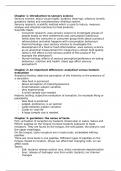Chapter 1: Introduction to sensory science
Sensory science: about visual (sight), auditory (hearing), olfactory (smell),
gustatory (taste) and somatosensory (feeling) system.
Sensory research: scientific method which is used to induce, measure,
analyse and interpret reactions to food products.
Scientific fields:
- Consumer research: uses sensory science to investigate groups of
people based on their preferences and consumption behaviour.
(what does the consumer or consumer group think about a product
reformulation and what happens with consumption behaviour)
- Food technology: uses sensory science to investigate the
development of a food or food reformulation, uses sensory science
as an analytical measurement for measuring a certain food quality.
(what is the effect on the sensory profile of this product? For
example the aftertaste?)
- Human biology: effects of sensory perception/preference on eating
behaviour, nutrition and health. (does age affect sensory
perception?)
Chapter 2: An important difference: analytical versus hedonic
evaluation
Analytical testing: objective perception of the intensity or the presence of
a sensation.
- How food is perceived
- About perception of intensity/presence
- Small between-subject variation
- Very experimental
- A small sample size needed
Hedonic testing: subjective evaluation of sensation, for example liking or
palatability.
- How food is preferred
- Judged, preference, is an opinion
- Large between-subject variation
- Closer to ‘real life’
- A large sample size is needed.
Chapter 3: gustation: the sense of taste
First, activation of receptors by tastants (molecules) in saliva. Saliva and
filiform papillae on the tongue increase tastants exposure to taste
receptors. They are found on the tongue, the soft palate, the pharynx and
the upper esophagus.
On the tongue, taste receptors are in taste buds, embedded withing
papillae.
There are more buds in one papillae. Different types of papillae on the
tongue, based on location. Drugs can affect fast changing cells, so can
affect taste.
Tastes:
- Salt: tastants release sodium ions, direct membrane depolarization
- Sour: release of hydrogen ions from acidic tastants, ion channel
changes
, - Sweet: have hydroxyl and carbonyl groups, activate G-protein
coupled receptors.
- Bitter: more than 30 bitter receptors.
- Savory : glutamate activates savory receptors, the addition of
monosodium glutamate (MSG), to foods, enhances savory flavour.
Taste Tastant Receptor
Sweet Saccharides and sugar T1R2, T1R3
alcohols (no calories)
Sour Acids (H+) PKD2L1
Salt Inorganic salts: NaCl, ENaC
KCl
Umami MSG, glutamates, T1R1, T1R3
nucleotides (contains
also lots of slat, so
umami is not per
definition better than
salt.)
Bitter Caffeine, quinine, T2R
saccharine (triggers
sweet and bitter
receptors)
All water soluble.
Fat-taste receptor: neural response when free fatty acids bind. Not 6th taste
yet.
Functions taste buds:
- Distribute tastant over tongue
- Contain receptor cells
- You can taste every taste over the whole tongue, not on several
places, it is the density of the receptors that determine on which
place you taste the taste better.
4 types of papillae:
- Circumvallate papillae: largest type, near the back of tongue in a V,
more than 100 taste buds per papillae.
- Foliate papillae: side of tongue, 100 taste buds per papillae.




